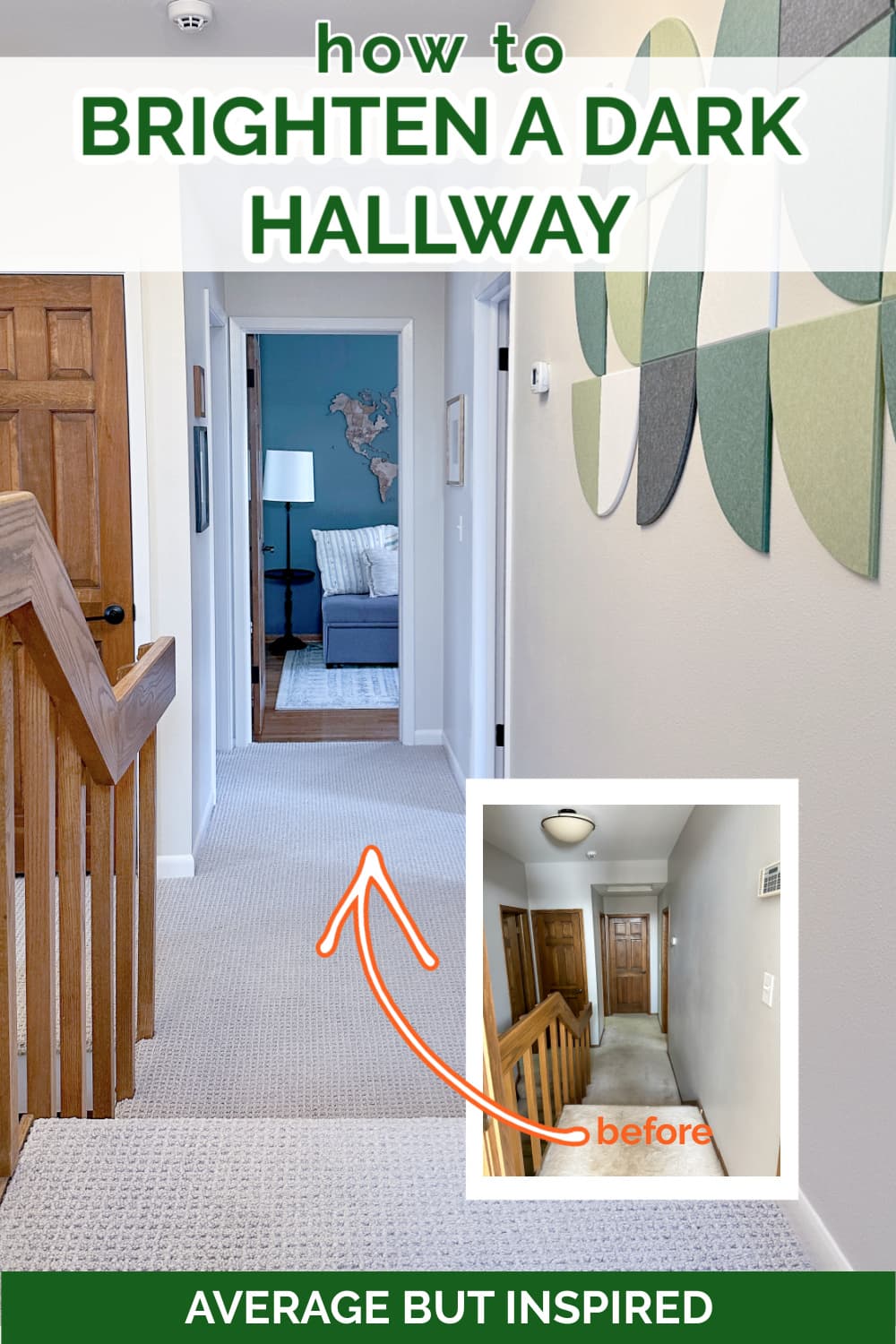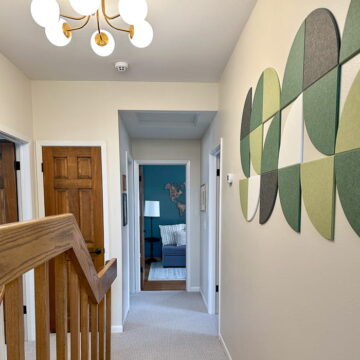Dark hallway giving you the blues? Here are practical tips for how to brighten a dark hallway or dark space with little to no natural lighting.
After transforming my home’s staircase, I moved on to preparing the upstairs for new carpet. The biggest concern was making my dark, dingy hallway look less like an afterthought and more like a welcoming space with some visual interest.
With no windows and only a tiny bit of natural light coming in from adjacent rooms, it was a challenge to brighten up this boring space. But, a few key changes made a huge difference, and they can help with any dark spaces in your home, too.

This post contains affiliate links. For more information, please read my disclosure policy.
Before: A Dark, Narrow Hallway
Prior to this project, I did exactly zero things to this upstairs hallway since we moved in. Nothing.

With its original brown wood doors and trim, purple-hued wall paint, underpowered and dust collecting light fixture, and stained carpeting, it felt like a dungeon.

I really, really did not like it.
Repaint the Walls a New Light Paint Color
The first thing I did to this dark hallway was swap the grayish/purple wall paint for a soft white wall color. I read an awesome article by Kylie M Interiors about Not Boring Paint Colors to Brighten a Dark Hallway, and her tips on the importance of considering the paint’s LRV in dark spaces were so helpful.
(LRV stands for Light Reflectance Value. The higher a paint’s LRV, the more light it will reflect.)
I sampled several colors and eventually chose the Benjamin Moore color Ballet White, but had it mixed in Behr Scuff Defense (Eggshell sheen) paint.

Because this is such a narrow hallway, and also because my son feels the need to touch the walls constantly, I wanted a scuff resistant paint. The Benjamin Moore scuff defense paint was not available near me (and it was WAY more expensive than the Behr Scuff Defense paint).
I didn’t love applying the Behr Scuff Defense paint because it ran and dripped very easily: much more so than any other paint I’ve used. But, so far it is holding up really well (especially in our narrow staircase that was totally beaten up before). So, I think it was a good choice.
Ballet White has a LRV of 72, so it reflects light well in this dark hallway. It also does not look like stark white walls can – sterile and unwelcoming. Instead, it’s a creamy white with warmth that makes this hallway feel cozy.
The eggshell sheen also reflects light well – much more so than matte paint, for example, so that finish was a great choice in a dark space.
White Door Frames with Wood Doors
Next, I made a “controversial” move by painting the trim around the doors or the door frames in Benjamin Moore’s color White Dove.

We had new baseboards installed in anticipation of our new carpet, and they were painted White Dove. While I didn’t want to get rid of all of the wood finishes in our home, I did want to modernize and brighten the trim.
I cleaned all of the trim with Krud Kutter, primed with stain blocking adhesion primer, and applied two coats of Behr Urethane Alkyd Enamel paint (semigloss sheen) to the door frames.
I also updated the door handles to a modern matte black handle, and shined them up with Howard Sun Shield wood conditioner (which was AMAZING, by the way).
I couldn’t believe how much more I liked these old wood doors with the white trim and new hardware. They looked so much fresher than before!
The white trim was another great way to reflect light and lighten things up in this dark hallway!
Install A Bigger Light Fixture
I could not WAIT to replace the ceiling light in this hallway. I am incapable of articulating just how much I disliked this bowl light, which collected bug carcasses and copious amounts of dust. Oh, and not to mention that it only held three dim light bulbs, which did nothing to illuminate the dark hall.

Adding light with a new six-light ceiling light has given this hallway SO much light and vibrance. It’s also a pretty fixture with modern style that really helps to update the entire hallway.

Add Colorful Artwork
Adding some visual interest to this dark hallway with some artwork on the walls in a complimentary color palette also helped brighten things up.
Since its a long narrow hallway, I needed artwork that wasn’t too deep or thick. My family would definitely knock it off the walls.
I chose to install a peel and stick Felt Right wall mural because it added so much color to this space without protruding too far off the walls, and without me having to nail anything into the walls! It’s so funky and fun, and it’s absolutely perfect for this narrow space.
Use code BRE10 to save 10% at Felt Right

I also hung a few framed art prints on the opposite end of the hallway. Surprisingly (to me), the clear glass bounces light around from the adjoining rooms’ windows! So, that has been a great way to add light to this dark hallway, too.
Choose Light Colored Flooring
As I mentioned, I began this whole process because we were having new carpeting installed. (I didn’t want to be painting with new carpet on the floors.). The light color we chose worked well with the paint color palette and art colors, and helped keep things as bright as possible.

If you aren’t in the process of installing new flooring, one way to lighten up the flooring is to put down a runner in light or bright colors.
* * *
Of course this hallway would be so much brighter if it had any natural light source, but it doesn’t so I had to work with what I’ve got, as usual! I think that by focusing on finishes that reflect light and bounce light, as opposed to those that absorb light, I was able to make this dark hallway makeover a success.

If you’re able to do more than I was, here are some other great ways to make any dark hallway brighter:
- Add more natural light with skylights or solar tubes;
- Install doors with translucent glass panes or frosted glass panes;
- Paint dark wood doors a light paint color with a high LRV and in a reflective paint finish;
- Incorporate multiple light sources. In addition to ceiling lights, add wall sconces or wall lights, picture lights, table lamps or even a floor lamp if the hallway is big enough;
- Hang mirrors in strategic places to bounce light around a dark hallway. You could even create a gallery wall of mirrors or hang a tall or floor length mirror if space permits.

I hope that my dark hallway makeover and these additional ideas give you some ideas on how to brighten your own dark hallway!

